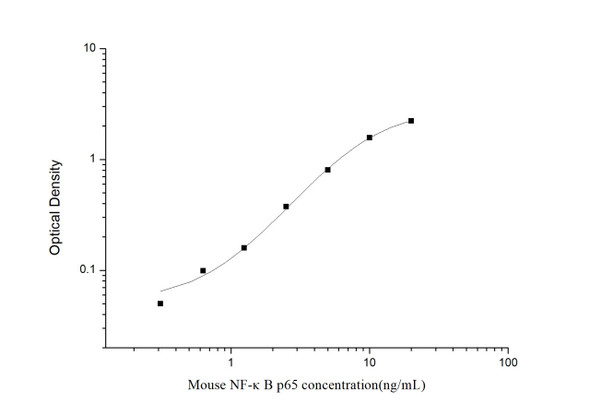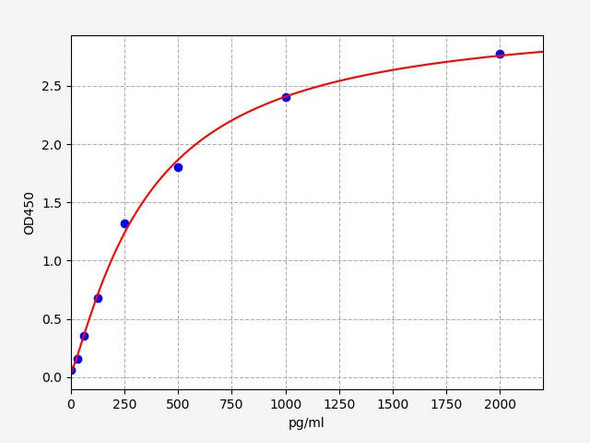Description
Mouse Transcription factor p65 (Rela) ELISA Kit
The Mouse Transcription Factor p65 (RelA) ELISA Kit is a highly sensitive and specific assay designed for the accurate detection of p65 (RelA) levels in mouse serum, plasma, and cell culture supernatants. This kit provides reliable and reproducible results, making it an essential tool for researchers studying transcription factor activity and regulatory pathways in mice.p65 (RelA) is a key transcription factor that plays a critical role in the regulation of gene expression, inflammation, and immune response. Dysregulation of p65 (RelA) has been associated with various diseases, including cancer, autoimmune disorders, and inflammatory conditions.
Therefore, accurate measurement of p65 (RelA) levels is crucial for understanding its role in disease pathogenesis and designing targeted therapies.With its high sensitivity and specificity, the Mouse Transcription Factor p65 (RelA) ELISA Kit offers researchers a reliable and efficient method for quantifying p65 (RelA) levels in mouse samples. Whether investigating signaling pathways, studying disease mechanisms, or screening potential therapeutic agents, this kit is a valuable resource for advancing research in the field of transcription factor biology.
| Product Name: | Mouse Transcription factor p65 (Rela) ELISA Kit |
| SKU: | MOEB0493 |
| Size: | 96T |
| Target: | Mouse Transcription factor p65 (Rela) |
| Synonyms: | Nuclear factor NF-kappa-B p65 subunit, Nuclear factor of kappa light polypeptide gene enhancer in B-cells 3, Nfkb3 |
| Assay Type: | Sandwich |
| Detection Method: | ELISA |
| Reactivity: | Mouse |
| Detection Range: | 0.235-15ng/mL |
| Sensitivity: | 0.121ng/mL |
| Intra CV: | 8.3% | ||||||||||||||||||||
| Inter CV: | 9.6% | ||||||||||||||||||||
| Linearity: |
| ||||||||||||||||||||
| Recovery: |
| ||||||||||||||||||||
| Function: | NF-kappa-B is a pleiotropic transcription factor present in almost all cell types and is the endpoint of a series of signal transduction events that are initiated by a vast array of stimuli related to many biological processes such as inflammation, immunity, differentiation, cell growth, tumorigenesis and apoptosis. NF-kappa-B is a homo- or heterodimeric complex formed by the Rel-like domain-containing proteins RELA/p65, RELB, NFKB1/p105, NFKB1/p50, REL and NFKB2/p52 and the heterodimeric p65-p50 complex appears to be most abundant one. The dimers bind at kappa-B sites in the DNA of their target genes and the individual dimers have distinct preferences for different kappa-B sites that they can bind with distinguishable affinity and specificity. Different dimer combinations act as transcriptional activators or repressors, respectively. NF-kappa-B is controlled by various mechanisms of post-translational modification and subcellular compartmentalization as well as by interactions with other cofactors or corepressors. NF-kappa-B complexes are held in the cytoplasm in an inactive state complexed with members of the NF-kappa-B inhibitor (I-kappa-B) family. In a conventional activation pathway, I-kappa-B is phosphorylated by I-kappa-B kinases (IKKs) in response to different activators, subsequently degraded thus liberating the active NF-kappa-B complex which translocates to the nucleus. NF-kappa-B heterodimeric p65-p50 and p65-c-Rel complexes are transcriptional activators. The NF-kappa-B p65-p65 complex appears to be involved in invasin-mediated activation of IL-8 expression (By similarity). The inhibitory effect of I-kappa-B upon NF-kappa-B the cytoplasm is exerted primarily through the interaction with p65. p65 shows a weak DNA-binding site which could contribute directly to DNA binding in the NF-kappa-B complex. Associates with chromatin at the NF-kappa-B promoter region via association with DDX1. Essential for cytokine gene expression in T-cells. |
| Uniprot: | Q04207 |
| Sample Type: | Serum, plasma, tissue homogenates, cell culture supernates and other biological fluids |
| Specificity: | Natural and recombinant mouse Transcription factor p65 |
| Sub Unit: | Component of the NF-kappa-B p65-p50 complex. Component of the NF-kappa-B p65-c-Rel complex. Homodimer; component of the NF-kappa-B p65-p65 complex. Component of the NF-kappa-B p65-p52 complex. May interact with ETHE1. Binds AES and TLE1. Interacts with TP53BP2. Binds to and is phosphorylated by the activated form of either RPS6KA4 or RPS6KA5. Interacts with ING4 and this interaction may be indirect. Interacts with CARM1, USP48 and UNC5CL. Interacts with IRAK1BP1. Interacts with NFKBIA. Interacts with GSK3B. Interacts with NFKBIB. Interacts with NFKBIE. Interacts with NFKBIZ. Part of a 70-90 kDa complex at least consisting of CHUK, IKBKB, NFKBIA, RELA, IKBKAP and MAP3K14. Interacts with HDAC3; HDAC3 mediates the deacetylation of RELA. Interacts with HDAC1; the interaction requires non-phosphorylated RELA. Interacts with CBP; the interaction requires phosphorylated RELA. Interacts (phosphorylated at 'Thr-254') with PIN1; the interaction inhibits p65 binding to NFKBIA. Interacts with SOCS1. Interacts with MTDH and PHF11. Interacts with NFKBID. Interacts with ARRB2. Interacts with NFKBIA (when phosphorylated), the interaction is direct; phosphorylated NFKBIA is associated with a SCF(BTRC)-like complex lacking CUL1. Interacts with RNF25. Interacts (via C-terminus) with DDX1 (By similarity). Interacts with UFL1 and COMMD1 (By similarity). Interacts with BRMS1; this promotes deacetylation of 'Lys-310'. Interacts (when acetylated at Lys-310) with BRD4; leading to activation of the NF-kappa-B pathway (By similarity). Interacts with EHMT1 (via ANK repeats). Interacts with NOTCH2. Directly interacts with MEN1; this interaction represses NFKB-mediated transactivation (By similarity). Interacts with AKIP1, which promotes the phosphorylation and nuclear retention of RELA (By similarity). Interacts (via the RHD) with GFI1; the interaction, after bacterial lipopolysaccharide (LPS) stimulation, inhibits the transcriptional activity by interfering with the DNA-binding activity to target gene promoter DNA. Interacts with MEFV (By similarity). Interacts with CLOCK. Interacts with FOXP3 (By similarity). Interacts (via N-terminus) with CPEN1; this interaction induces proteolytic cleavage of p65/RELA subunit and inhibition of NF-kappa-B transcriptional activity (By similarity). Interacts with CDK5RAP3; stimulates the interaction of RELA with HDAC1, HDAC2 and HDAC3 thereby inhibiting NF-kappa-B transcriptional activity. |
| Research Area: | Neurosciences |
| Subcellular Location: | Nucleus Cytoplasm Colocalized with DDX1 in the nucleus upon TNF-alpha induction (By similarity). Nuclear, but also found in the cytoplasm in an inactive form complexed to an inhibitor (I-kappa-B). Colocalizes with GFI1 in the nucleus after lipopolysaccharide (LPS) stimulation. |
| Storage: | Please see kit components below for exact storage details |
| Note: | For research use only |
| UniProt Protein Function: | NFkB-p65: a subunit of NF-kappa-B transcription complex, which plays a crucial role in inflammatory and immune responses. The inhibitory effect of I-kappa-B upon NF-kappa-B in the cytoplasm is exerted primarily through the interaction with p65. P65 shows a weak DNA-binding site which could contribute directly to DNA binding in the NF-kappa-B complex. There are five NFkB proteins in mammals (RelA/NFkB-p65, RelB, c-Rel, NF-_B1/NFkB-p105, and NF-_B2/NFkB-p100). They form a variety of homodimers and heterodimers, each of which activates its own characteristic set of genes. Three splice-variant isoforms have been identified. |
| UniProt Protein Details: | Protein type:Transcription factor; DNA-binding; Nuclear receptor co-regulator Cellular Component: cytoplasm; cytosol; nucleus; protein complex; transcription factor complex Molecular Function:actinin binding; chromatin binding; chromatin DNA binding; DNA binding; enzyme binding; histone deacetylase binding; identical protein binding; NF-kappaB binding; phosphate binding; protein binding; protein complex binding; protein heterodimerization activity; protein homodimerization activity; protein kinase binding; protein N-terminus binding; RNA polymerase II transcription factor activity, enhancer binding; sequence-specific DNA binding; transcription activator binding; transcription factor activity; transcription factor binding; ubiquitin protein ligase binding Biological Process: activation of NF-kappaB transcription factor; cytokine and chemokine mediated signaling pathway; defense response; hair follicle development; I-kappaB kinase/NF-kappaB cascade; inflammatory response; innate immune response; liver development; negative regulation of apoptosis; negative regulation of insulin receptor signaling pathway; negative regulation of protein catabolic process; negative regulation of transcription from RNA polymerase II promoter; negative regulation of transcription, DNA-dependent; organ morphogenesis; positive regulation of cell proliferation; positive regulation of chondrocyte differentiation; positive regulation of I-kappaB kinase/NF-kappaB cascade; positive regulation of interleukin-12 biosynthetic process; positive regulation of Schwann cell differentiation; positive regulation of transcription from RNA polymerase II promoter; positive regulation of transcription, DNA-dependent; regulation of inflammatory response; regulation of transcription, DNA-dependent; response to bacterium; response to cytokine stimulus; response to muramyl dipeptide; response to organic substance; response to UV-B; transcription from RNA polymerase II promoter; transcription, DNA-dependent |
| UniProt Code: | Q04207 |
| NCBI GenInfo Identifier: | 417926 |
| NCBI Gene ID: | 19697 |
| NCBI Accession: | Q04207.1 |
| UniProt Secondary Accession: | Q04207,Q62025, |
| UniProt Related Accession: | Q04207 |
| Molecular Weight: | 59,061 Da |
| NCBI Full Name: | Transcription factor p65 |
| NCBI Synonym Full Names: | v-rel reticuloendotheliosis viral oncogene homolog A (avian) |
| NCBI Official Symbol: | Rela |
| NCBI Official Synonym Symbols: | p65 |
| NCBI Protein Information: | transcription factor p65 |
| UniProt Protein Name: | Transcription factor p65 |
| UniProt Synonym Protein Names: | Nuclear factor NF-kappa-B p65 subunit; Nuclear factor of kappa light polypeptide gene enhancer in B-cells 3 |
| UniProt Gene Name: | Rela |
| UniProt Entry Name: | TF65_MOUSE |
| Component | Quantity (96 Assays) | Storage |
| ELISA Microplate (Dismountable) | 8×12 strips | -20°C |
| Lyophilized Standard | 2 | -20°C |
| Sample Diluent | 20ml | -20°C |
| Assay Diluent A | 10mL | -20°C |
| Assay Diluent B | 10mL | -20°C |
| Detection Reagent A | 120µL | -20°C |
| Detection Reagent B | 120µL | -20°C |
| Wash Buffer | 30mL | 4°C |
| Substrate | 10mL | 4°C |
| Stop Solution | 10mL | 4°C |
| Plate Sealer | 5 | - |
Other materials and equipment required:
- Microplate reader with 450 nm wavelength filter
- Multichannel Pipette, Pipette, microcentrifuge tubes and disposable pipette tips
- Incubator
- Deionized or distilled water
- Absorbent paper
- Buffer resevoir
*Note: The below protocol is a sample protocol. Protocols are specific to each batch/lot. For the correct instructions please follow the protocol included in your kit.
Allow all reagents to reach room temperature (Please do not dissolve the reagents at 37°C directly). All the reagents should be mixed thoroughly by gently swirling before pipetting. Avoid foaming. Keep appropriate numbers of strips for 1 experiment and remove extra strips from microtiter plate. Removed strips should be resealed and stored at -20°C until the kits expiry date. Prepare all reagents, working standards and samples as directed in the previous sections. Please predict the concentration before assaying. If values for these are not within the range of the standard curve, users must determine the optimal sample dilutions for their experiments. We recommend running all samples in duplicate.
| Step | |
| 1. | Add Sample: Add 100µL of Standard, Blank, or Sample per well. The blank well is added with Sample diluent. Solutions are added to the bottom of micro ELISA plate well, avoid inside wall touching and foaming as possible. Mix it gently. Cover the plate with sealer we provided. Incubate for 120 minutes at 37°C. |
| 2. | Remove the liquid from each well, don't wash. Add 100µL of Detection Reagent A working solution to each well. Cover with the Plate sealer. Gently tap the plate to ensure thorough mixing. Incubate for 1 hour at 37°C. Note: if Detection Reagent A appears cloudy warm to room temperature until solution is uniform. |
| 3. | Aspirate each well and wash, repeating the process three times. Wash by filling each well with Wash Buffer (approximately 400µL) (a squirt bottle, multi-channel pipette,manifold dispenser or automated washer are needed). Complete removal of liquid at each step is essential. After the last wash, completely remove remaining Wash Buffer by aspirating or decanting. Invert the plate and pat it against thick clean absorbent paper. |
| 4. | Add 100µL of Detection Reagent B working solution to each well. Cover with the Plate sealer. Incubate for 60 minutes at 37°C. |
| 5. | Repeat the wash process for five times as conducted in step 3. |
| 6. | Add 90µL of Substrate Solution to each well. Cover with a new Plate sealer and incubate for 10-20 minutes at 37°C. Protect the plate from light. The reaction time can be shortened or extended according to the actual color change, but this should not exceed more than 30 minutes. When apparent gradient appears in standard wells, user should terminatethe reaction. |
| 7. | Add 50µL of Stop Solution to each well. If color change does not appear uniform, gently tap the plate to ensure thorough mixing. |
| 8. | Determine the optical density (OD value) of each well at once, using a micro-plate reader set to 450 nm. User should open the micro-plate reader in advance, preheat the instrument, and set the testing parameters. |
| 9. | After experiment, store all reagents according to the specified storage temperature respectively until their expiry. |
When carrying out an ELISA assay it is important to prepare your samples in order to achieve the best possible results. Below we have a list of procedures for the preparation of samples for different sample types.
| Sample Type | Protocol |
| Serum | If using serum separator tubes, allow samples to clot for 30 minutes at room temperature. Centrifuge for 10 minutes at 1,000x g. Collect the serum fraction and assay promptly or aliquot and store the samples at -80°C. Avoid multiple freeze-thaw cycles. If serum separator tubes are not being used, allow samples to clot overnight at 2-8°C. Centrifuge for 10 minutes at 1,000x g. Remove serum and assay promptly or aliquot and store the samples at -80°C. Avoid multiple freeze-thaw cycles. |
| Plasma | Collect plasma using EDTA or heparin as an anticoagulant. Centrifuge samples at 4°C for 15 mins at 1000 × g within 30 mins of collection. Collect the plasma fraction and assay promptly or aliquot and store the samples at -80°C. Avoid multiple freeze-thaw cycles. Note: Over haemolysed samples are not suitable for use with this kit. |
| Urine & Cerebrospinal Fluid | Collect the urine (mid-stream) in a sterile container, centrifuge for 20 mins at 2000-3000 rpm. Remove supernatant and assay immediately. If any precipitation is detected, repeat the centrifugation step. A similar protocol can be used for cerebrospinal fluid. |
| Cell culture supernatant | Collect the cell culture media by pipette, followed by centrifugation at 4°C for 20 mins at 1500 rpm. Collect the clear supernatant and assay immediately. |
| Cell lysates | Solubilize cells in lysis buffer and allow to sit on ice for 30 minutes. Centrifuge tubes at 14,000 x g for 5 minutes to remove insoluble material. Aliquot the supernatant into a new tube and discard the remaining whole cell extract. Quantify total protein concentration using a total protein assay. Assay immediately or aliquot and store at ≤ -20 °C. |
| Tissue homogenates | The preparation of tissue homogenates will vary depending upon tissue type. Rinse tissue with 1X PBS to remove excess blood & homogenize in 20ml of 1X PBS (including protease inhibitors) and store overnight at ≤ -20°C. Two freeze-thaw cycles are required to break the cell membranes. To further disrupt the cell membranes you can sonicate the samples. Centrifuge homogenates for 5 mins at 5000xg. Remove the supernatant and assay immediately or aliquot and store at -20°C or -80°C. |
| Tissue lysates | Rinse tissue with PBS, cut into 1-2 mm pieces, and homogenize with a tissue homogenizer in PBS. Add an equal volume of RIPA buffer containing protease inhibitors and lyse tissues at room temperature for 30 minutes with gentle agitation. Centrifuge to remove debris. Quantify total protein concentration using a total protein assay. Assay immediately or aliquot and store at ≤ -20 °C. |
| Breast Milk | Collect milk samples and centrifuge at 10,000 x g for 60 min at 4°C. Aliquot the supernatant and assay. For long term use, store samples at -80°C. Minimize freeze/thaw cycles. |










